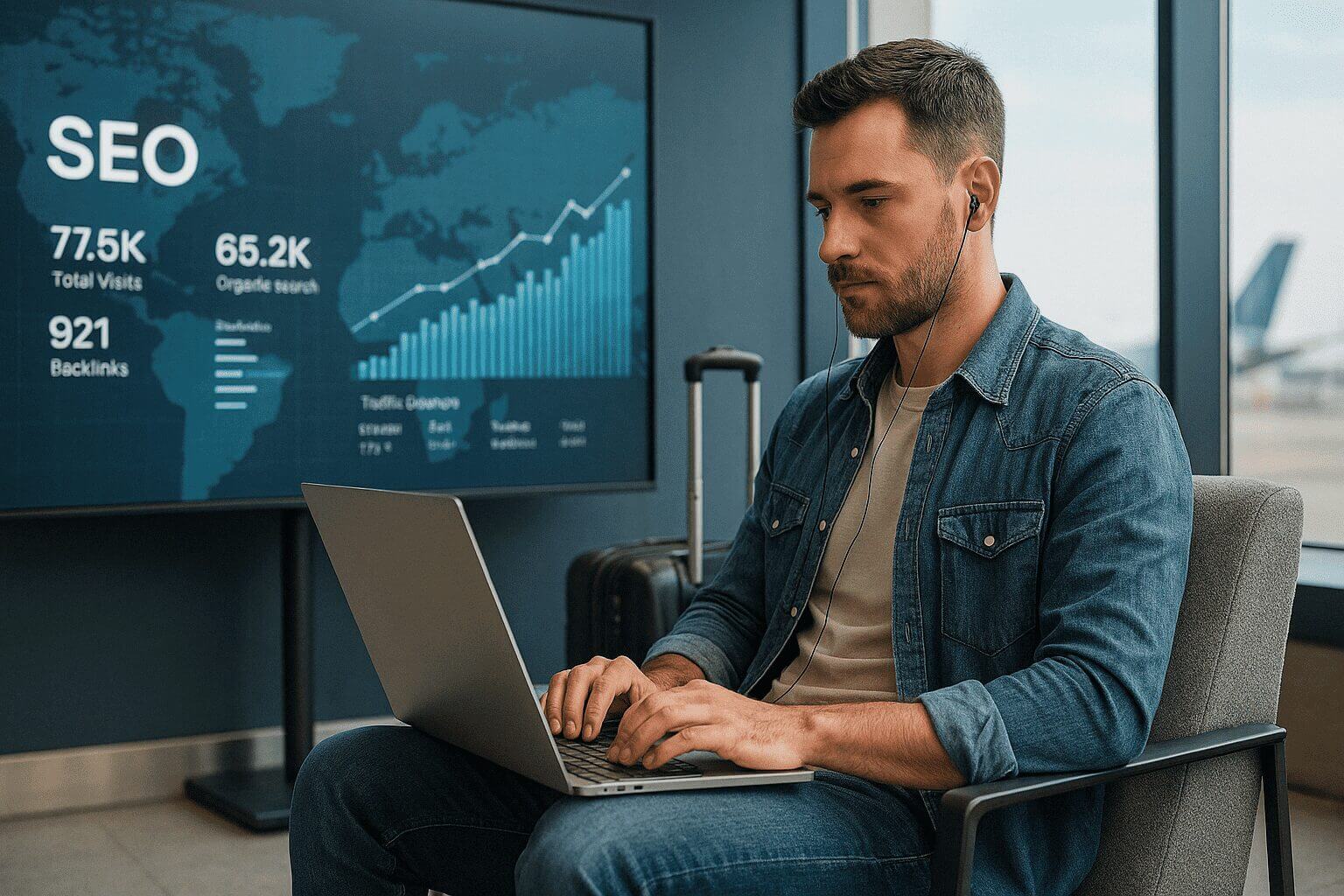Key Takeaways
- Popular travel blog keywords include “travel blog” (90,500 monthly searches), “family travel blog” (27,100), and “luxury travel” (8,100)
- Structuring content with clear headings, short paragraphs, and visual elements increases engagement by up to 80%
- Effective keyword research using tools like Semrush and Ahrefs is essential for identifying valuable keywords with the right search intent
- Tech integration through interactive maps, app reviews, and data visualizations sets your travel blog apart from competitors
- Demonstrating E-E-A-T principles through personal experiences and expert information significantly improves search visibility
Understanding Your Travel Blog Niche and Audience
The foundation of any successful tech-savvy travel blog begins with clearly defining your specific niche. With millions of travel blogs competing for attention, standing out requires focusing on a particular segment of travel that aligns with your expertise.
Popular Travel Blog Niches:
- Digital nomad lifestyle and remote work destinations
- Adventure travel with technology integration
- Luxury travel experiences enhanced by apps and gadgets
- Budget travel optimization through technology
- Family travel planning with tech solutions
Understanding who you’re writing for shapes everything from your content topics to your writing style. Create a detailed audience profile by analyzing demographics, tech preferences, and travel habits of your ideal readers.
A travel blog targeting business professionals who take frequent short trips will differ significantly from one aimed at long-term backpackers. The first might focus on productivity tools and quick city guides, while the second emphasizes connectivity solutions in remote locations.
Essential SEO Strategies for Travel Blogs
Search Engine Optimization (SEO) transforms your travel content from hidden gem to discovered destination. The journey begins with thorough keyword research.
Keyword Research and Implementation
Top Travel Keywords by Search Volume:
| Keyword | Monthly Search Volume |
|---|---|
| travel blog | 90,500 |
| family travel blog | 27,100 |
| luxury travel | 8,100 |
| adventure travel blog | 8,100 |
| digital nomad destinations | 6,600 |
| travel tech essentials | 4,400 |
Begin by identifying keywords that match both your niche and what your audience is searching for. Use tools like:
- Google Keyword Planner – Free basic search volume data
- Semrush – Comprehensive keyword analysis with competitor insights
- Ahrefs – Excellent for finding keyword gaps in competitor content
- AnswerThePublic – Visualizes questions people ask about travel topics
Strategic Keyword Placement:
Place your primary keyword naturally in these key locations:
- Article title
- First paragraph
- At least one H2 subheading
- Image alt text
- URL structure
- Meta description
For example, a post about working remotely from Bali might target “digital nomad Bali” as the primary keyword, with related terms like “best coworking spaces Bali” and “remote work visa Bali” as secondary keywords.

Creating Tech-Enhanced Travel Content That Ranks
Modern travel blogs stand out by integrating technology directly into their content. This approach satisfies both readers and search engines looking for comprehensive, valuable information.
Tech Elements to Include:
- Interactive Maps – Embed Google Maps with custom pins showing recommended locations
- Data Visualizations – Create charts comparing prices, weather patterns, or visitor statistics
- Tool Recommendations – Review travel apps, gadgets, and online services with pros and cons
- Step-by-Step Tutorials – Show how to use tech tools in travel contexts (e.g., setting up a mobile hotspot)
One travel blogger increased page engagement by 74% by adding an interactive cost comparison calculator to destination guides. The tool allowed readers to adjust their travel style preferences and see personalized budget estimates.
Optimizing Content Structure for Readability
The structure of your travel blog posts directly impacts both user experience and SEO performance. Tech-savvy audiences appreciate well-organized content they can easily scan and digest.
Essential Structure Elements:
- Clear Heading Hierarchy – Use H2s for main sections and H3s for subsections
- Short Paragraphs – Limit to 2-3 sentences each
- Bulleted Lists – Break down complex information into scannable points
- Bold Text – Highlight key information and statistics
- Tables – Present comparative information clearly
- Visual Breaks – Use images, pull quotes, or callout boxes every 300 words
A major travel site tested two versions of the same content – one as a traditional article and one with enhanced structure elements. The structured version showed a 43% longer average time on page and 28% lower bounce rate.
Leveraging Technology Tools for Travel Bloggers
The modern travel blogger has access to powerful tools that enhance both content creation and audience engagement.
Essential Tech Tools:
- Google Analytics 4 – Track visitor behavior, popular content, and conversion paths
- Canva or Adobe Express – Create professional graphics and Pinterest-optimized images
- Loom or Screencast-O-Matic – Record quick video tutorials for complex travel tech
- Notion or Trello – Organize content calendars and travel research
- Mobile Photography Apps – Enhance travel photos with tools like Snapseed or Lightroom Mobile
One travel blogger specializing in photography destinations uses a custom Google Data Studio dashboard to track which types of photography tutorials drive the most affiliate sales for camera equipment, allowing for more targeted content creation.
Building Authority with E-E-A-T Principles
Google’s E-E-A-T principles (Experience, Expertise, Authoritativeness, Trustworthiness) have become increasingly important for travel content. Demonstrating these qualities helps your blog rank higher, especially for topics related to safety, health, or financial decisions.
Ways to Demonstrate E-E-A-T:
- Share Personal Experiences – “During my three-month stay testing coworking spaces across Bali, I discovered that download speeds varied by up to 85% between locations”
- Include Expert Opinions – Interview local guides, technology specialists, or other travel professionals
- Present Verified Data – Include statistics from trusted sources about destinations, trends, or technology adoption
- Show Credentials – Mention relevant certifications, years of experience, or special access
A travel safety blogger saw a 156% increase in traffic after reorganizing content to highlight their background in cybersecurity and adding detailed firsthand accounts of testing VPN reliability across restricted-internet countries.
Engaging Your Travel Blog Audience
Creating great content is only half the battle – engaging your audience drives loyalty, shares, and return visits.
Effective Engagement Strategies:
- End posts with thought-provoking questions that encourage comments
- Create polls and surveys about travel preferences or technology usage
- Share user-generated content from readers who followed your recommendations
- Respond quickly to comments with helpful additional information
- Develop email sequences that deliver destination-specific tech tips
When one travel blogger added interactive decision trees to help readers choose the right travel insurance based on their tech gear value, comment engagement increased by 340% and affiliate conversions rose by 28%.
Measuring Success with Analytics
Data-driven decisions separate successful travel blogs from those that plateau. Regular analysis helps identify what’s working and opportunities for improvement.
Key Metrics to Track:
- Organic traffic growth by landing page and keyword
- Average time on page for different content types
- Click-through rates from search results
- Mobile vs. desktop usage patterns
- Conversion rates for affiliate links and email signups
Set up custom dashboards in Google Analytics that focus on your specific goals – whether building an email list, driving affiliate revenue, or increasing destination-specific pageviews.
One travel blogger discovered that their detailed transportation guides outperformed their accommodation reviews by 267% in both traffic and affiliate revenue, leading to a strategic shift in content priorities.
FAQ: Tech-Savvy Travel Blogging
How often should I publish new content on my travel blog?
Quality matters more than quantity. For most travel blogs, publishing 1-2 highly researched, comprehensive articles weekly delivers better results than daily shorter posts. Focus on creating definitive guides (1,500+ words) with unique insights rather than rushing to publish. Major algorithm updates increasingly favor comprehensive content that thoroughly addresses user needs.
What’s the ideal blog post length for travel content?
The optimal length depends on the topic complexity and search intent. Destination guides perform best at 1,800-2,500 words, while specific topics like “best travel apps for Japan” might only need 1,200-1,500 words. Always prioritize covering the topic comprehensively over hitting a specific word count, as Google rewards content that fully satisfies user queries.
How can I make my travel blog stand out from competitors?
Differentiation comes from combining unique expertise with data-driven insights. Instead of generic “10 things to do in Paris” content, create specialized guides like “Complete Tech Guide to Working Remotely in Paris” with specifics on coworking spaces, coffee shops with reliable WiFi, and local SIM card options. Include proprietary data whenever possible, such as personal speed tests or comparative price research.
Should I focus on social media or SEO for my travel blog?
While both have value, SEO typically provides more sustainable long-term traffic. Social media requires constant feeding with new content, while well-optimized SEO content can drive traffic for years with occasional updates. The ideal approach combines both: use SEO as your traffic foundation and social media for community building and content promotion.
How can I monetize a tech-savvy travel blog effectively?
The most successful tech-travel blogs use multiple revenue streams: affiliate marketing for travel gear and booking sites, display advertising, sponsored content, digital products (like destination guides or presets), and membership programs offering exclusive content. Technology-focused content often converts better for high-ticket items like cameras, laptops, and premium software subscriptions compared to general travel content.
How important is mobile optimization for travel blogs?
Extremely important – over 70% of travel research now happens on mobile devices. Ensure your site loads in under 3 seconds on mobile, uses large enough fonts (minimum 16px), has easy-to-tap navigation elements, and incorporates responsive images. Google’s mobile-first indexing means your site’s mobile version determines your search rankings.




